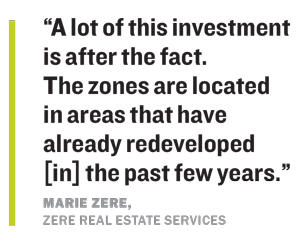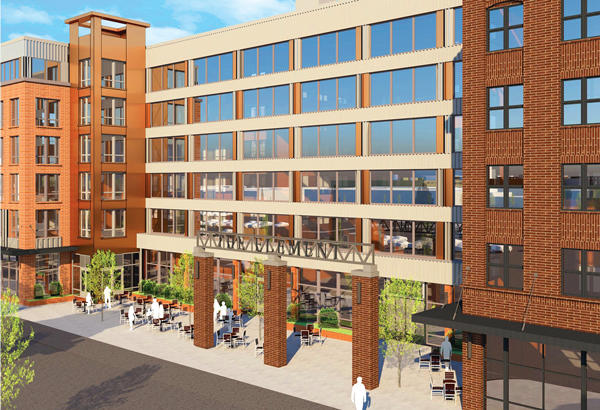Trending
Opportunity Zones beyond the metropolis
The tri-state area appears to be embracing the program, even if questions abound

Amid the seemingly incessant buzz in the real estate world about Opportunity Zones, real estate markets around New York City are starting to embrace the investments-for-tax-incentives program born out of the Tax Cuts and Jobs Act of 2017.
Across Long Island, northern New Jersey, southern Connecticut and Westchester County, developers are trying to woo money managers whose deep-pocketed clients could use the federal program to reduce their taxes on capital gains, which they can park in downtrodden or undeveloped neighborhoods.
While OZs have been slow to roll out, some shovels are hitting the ground, especially in New Jersey, whose U.S. Senator Cory Booker helped draft the legislation that led to the program’s creation. New York and Connecticut, however, have seen far less OZ activity, said brokers, investors and landlords. The program’s complicated reporting requirements have been so hard to decipher that many investors are waiting to get more clarity on the rules before investing. And the government appears ready to offer more of those details.
In March, barring any further government shutdowns, the U.S. Department of the Treasury is set to provide guidance on some OZ rules. The move could help private equity firms raise more OZ-focused funds and help developers shop around long-planned projects.
“I’m being pitched — and people are raising funds,” said Kathy Anderson, a founding partner of Tinton Falls, New Jersey-based mortgage lender Progress Capital Advisors. “It’s definitely happening.”
OZs provide tax deferments for those who pour money into projects in neighborhoods selected by individual states for development. The Internal Revenue Service will run the program, which has been heralded as a means to revitalize such areas. But not everyone is all in on OZs.
Critics claim the program, which relies on decade-old U.S. Census Bureau data, is being applied to areas that have been heavily gentrified in recent years, such as downtown Stamford, Connecticut. OZ opponents also argue that it’s a failure of public policy, since tax breaks would be given to developers for projects that will likely move forward anyway, while those who could actually benefit from such financial assistance get priced out of their homes due to gentrification.
From the perspective of investors, the financial gains from OZ projects in neighborhoods that have already turned around could be limited. But spruced-up downtowns are also less perilous real estate investment targets than undeveloped areas, which some analysts expect could appeal to risk-averse investors. Most of the Opportunity Zone funds that have been announced — including those from leading asset managers and development firms seeking to raise billions of dollars — appear to be most interested in New York City and other urban areas. Nonetheless, there is interest in secondary markets.
SkyBridge Capital, the hedge fund of short-lived former White House spokesman Anthony Scaramucci, has formed a $3 billion OZ-focused real estate investment trust. RXR Realty, a developer known for its work on Long Island and in other tri-state suburbs, has also formed an OZ fund pegged at $500 million, although the firm has been circumspect when asked about its size. Even smaller players like the St Katherine Group, a privately held real estate developer focused on Port Chester in Westchester County, are getting into the OZ game.
 “Landlords and investors are eager to take advantage,” said Ted Stratigos, a Melville, New York-based managing director and principal at the commercial brokerage Avison Young. “But sometimes these things are easier said than done.”
“Landlords and investors are eager to take advantage,” said Ted Stratigos, a Melville, New York-based managing director and principal at the commercial brokerage Avison Young. “But sometimes these things are easier said than done.”
Northern New Jersey
In the counties lining New Jersey’s northeastern flank — Bergen, Essex, Hudson, Passaic and Union — OZs are numerous, at 82, about half of the 169 approved statewide. And the Garden State seems eager to get the word out to potential investors.
Booker, the former Newark mayor-turned-Democratic presidential candidate, was an early backer of OZs, which have drawn bipartisan support. Booker co-sponsored the program — officially called the Investing in Opportunity Act and shoehorned into the tax bill — and the senator has publicly pitched it as a means to bolster low-income communities, or what he calls “domestic emerging markets.”
New Jersey’s Department of Community Affairs launched a website last fall that has a mapping tool designed to pinpoint OZ-related real estate. The website also identifies development sites within OZs, though only about a dozen were highlighted earlier this year, with some appearing to be projects in search of funds.
Postindustrial cities like Elizabeth, East Orange, Elizabeth, Newark and Passaic are packed with OZs, but they can also be found in heavily gentrified Jersey City, which has 11 designated OZs. Now could be an opportune time to invest in such areas, particularly when it comes to residential real estate.
In December, the median home value in New Jersey was $324,700, up nearly 6 percent over the course of 2018, according to online real estate firm Zillow Group, which predicts an additional increase of 7 percent this year.
Early movers include Passaic-based Stonegate Buildings, a nine-year-old developer that has shifted the proceeds from the sale of company-controlled securities into a self-managed OZ fund that will be deployed in a pair of rental projects in its home city.
Stonegate is planning a 52-unit building at 125 South Street in Passaic, a site it hopes to close on by April, said CEO Steven Gelbtuch, who declined to discuss the sale price since the deal is in progress. That potential project would be next to a $20 million, 63-unit rental conversion that Stonegate is currently developing in a former textile factory.
Stonegate hopes to close on 18 Van Houten Avenue, a church property in Passaic, this spring. The developer plans to build a 40-unit rental building on the site. Gelbtuch said rents for new one-bedrooms in Passaic are about $1,800 a month. He noted that developers who know how to handle property sales and manage multifamily housing are in a strong position when it comes to benefiting from OZs.
Also directly benefiting from OZ funding is the Element, a six-story, 631-unit rental building at 400 Claremont Avenue on the west side of Jersey City. The project, from a team that includes Dean Geibel, founder of Hoboken-based condo builder Metro Homes, broke ground in December, thanks in part to Progress Capital’s Anderson.
 The real estate financier, who is working on funding for the Element’s developers, said she received “a call from a client who had sold a lot of stock, had a huge capital gain, and wanted to invest it somewhere.” Anderson suggested the Element, whose $120 million price tag includes $40 million in equity.
The real estate financier, who is working on funding for the Element’s developers, said she received “a call from a client who had sold a lot of stock, had a huge capital gain, and wanted to invest it somewhere.” Anderson suggested the Element, whose $120 million price tag includes $40 million in equity.
“Instead of going out and finding high-priced equity, we can now get equity from investors looking for an upside,” Anderson said. The Element, located on a former industrial site across from a Hudson-Bergen Light Rail stop, will offer studios to two-bedrooms, as well as amenities like a saltwater pool and a lobby with a piano player.
In the fundraising space, Bernardsville, New Jersey-based 3P Equity Capital had, as of early February, begun raising a $300 million OZ fund, which it hopes to close within a year. The fund will initially target New Jersey, but it will also look at national real estate deals, said 3P’s CEO Christopher Otteau, whose firm touts its expertise in “urbanizing suburbia.”
Among those interested in working with 3P are family offices affiliated with high-net-worth individuals, said Otteau, noting that such investors like the fact that OZs allow just profits to be invested, not profit plus principal, as with 1031 exchanges. (The latter, narrower in scope, merely defer, rather than reduce, capital gains taxes.)
Sites that could become beneficiaries of 3P’s potential OZ largesse so far remain just outside the primary suburban belt, such as in New Brunswick in Middlesex County. But 3P is currently looking at projects in Newark, Otteau said, including a project with the New Jersey Institute of Technology. “We are well ahead of the curve,” he said.
Nassau County
New York, with more than double the population of New Jersey and almost seven times the land mass, has triple the number of OZs as its neighbor. Counties with more low-income tracts typically got more OZs, but each of New York’s 62 counties got at least one, for a grand total of 514.
Long Island, with 34 low-income tracts in Nassau and Suffolk counties, ended up with 10 OZs, with Nassau getting four of them. Not making the cut in Nassau were places like New Cassel, Salisbury and Inwood — the latter is near Far Rockaway, Queens — but Long Beach, Glen Cove and a pair of sites in Hempstead Village, all of which have been the focus of revitalization plans for decades, were approved.
“I think [OZs] are going to open the door,” said John Mavroudes, who has owned properties in Hempstead Village for almost two decades. “At one time, industry here was thriving. But for 40 years, it’s been the pits.”
In early November, aware of the new OZ designation in his neighborhood, Mavroudes listed a 2,800-square-foot, one-story brick warehouse for $729,000. Since then, about a dozen potential buyers have come around. One of them, representing a fund, said it was interested in the site due to the OZ credentials and made an offer, but it was “a little low,” said Mavroudes, noting that he’s still negotiating on the property.
Avison Young’s Stratigos said many real estate funds have five- to seven-year investment windows, but for the best results, OZs require a 10-year commitment. “It will favor long-term holders,” he added.
Generally speaking, secondary markets like those found in Long Island cities offer a good return on real estate investments, said SkyBridge president Brett Messing, who was hired in November to oversee the firm’s new OZ fund. Wilton, Connecticut-based Westport Capital Partners, an investment firm that specializes in distressed real estate, will help manage SkyBridge’s fund. Westport declined to comment.

The Element, a rental project located in a Jersey City OZ
“Places like Brooklyn have elevated prices, and there are robust assumptions about growth,” said Messing, citing Newark and New Rochelle as better areas of interest. Indeed, SkyBridge will consider multifamily, industrial and office investments or “any idiosyncratic opportunity we can find,” he added. “We are not excluding anyplace.”
Messing said that as of early February, $4.5 billion in national proposals had been pitched to him within a couple of weeks, with $750 million of them “actionable.” SkyBridge plans to raise its $3 billion fund over three years.
Others are also trying to get the OZ word out. On Feb. 12, law and accounting firms as well as RXR, a Uniondale-based developer targeting its own fund, presented a panel on the program at a Hilton hotel in Melville.
RXR president and CFO Michael Maturo told The Real Deal earlier this year that it was raising OZ money from high-net-worth individuals and the alternative investment arms of major banks. Maturo noted that RXR, which formed an emerging submarket fund in 2015 to invest in areas outside Manhattan, is now well-positioned to take advantage of OZs.
Suffolk County
Despite being home to the Hamptons, Suffolk still struggles economically.
Places like Copiague, East Brentwood and Mastic Beach were all eligible for the OZ program, but Central Islip, Huntington Station and Riverhead ultimately won out. So did Wyandanch, a once-blighted hamlet on a Long Island Rail Road line that in recent years has seen the rise of Wyandanch Village, a $500 million, 40-acre mixed-use project from the Albanese Organization.
Features of the massive development include stores, a skating rink and a pair of apartment buildings with 117 affordable and market-rate units, with more planned. But for OZ skeptics, choosing places like Wyandanch for the program blunts its effectiveness. Investors would rather be in a place with more room to grow.
“A lot of this investment is after the fact,” said Marie Zere, president of Zere Real Estate Services, a commercial firm based in nearby Ronkonkoma. “The zones are located in areas that have already redeveloped as recently as the past few years.”
The U.S. Census takes place every 10 years, and OZ selection was based on tract data from 2010, before a wave of projects began to rejuvenate suburban enclaves. Selected tracts need to have poverty rates of at least 20 percent, although a smaller portion of OZs can be more affluent areas that are adjacent to low-income neighborhoods.
Zere admitted that an OZ tag has helped market a 31-acre industrial site in the Calverton section of Riverhead, which was last listed for around $5 million until a contract went out on the site in January. The OZ designation “sealed the deal,” she said, but the developer, whom Zere would not identify, seemingly would have gone ahead with it anyway. The developer is poised to build up to a 400,000-square-foot, multi-tenant building on the site, Zere said. (No deed had been filed with the county on the deal at press time.)
The Calverton zone, near the North Fork, has been an active area for deals. Triple Five Worldwide, the retail and entertainment developer behind New Jersey’s American Dream Meadowlands project, was approved last fall to buy a 1,643-acre parcel where F-14 jets were once tested. Triple Five partnered with aeronautics manufacturer Luminati Aerospace on a $40 million acquisition of the Enterprise Park at Calverton. The site, once home to defense contractor Northrop Grumman, has a 10,000-foot runway, one of the longest on the East Coast.

Despite those trades, OZ transactional activity across Suffolk remained tepid into early February, said Zere, who has found the benefits of OZs to be limited.
“They are hard to grasp,” she said. “It’s so early on.”
Fairfield County
The Constitution State has 72 officially sanctioned OZs in 27 towns and cities, including 17 in Fairfield County. Those sites are mostly clustered in three cities: Bridgeport, Norwalk and Stamford, where developers have been busy in recent years putting up new apartment buildings. Stamford, with a population of 131,000, may be an unlikely beneficiary of the OZ program.
Local developer Building and Land Technology (BLT) has been transforming a low-rise manufacturing district in the city’s South End, near I-95, into a high-rise residential hub called Harbor Point. BLT broke ground on the megaproject in 2009. In 2016, it sold five apartment buildings with 1,214 units to New York-based Gaia Real Estate for $395 million. BLT is now building more apartments in the South End, all of which is blanketed in an OZ. (The developer did not return requests for comment.)
“If you did an analysis today, with current data, these areas might not fit,” said Elizabeth “Liddy” Karter, a managing director of Enhanced Capital Partners, a private equity and venture capital firm based in Stamford. “You take a little less risk, for a little less reward,” she added about the upside of OZs. “It’s a tradeoff.”
Housing prices in Fairfield, however, have been soft. The average sales price in the county during the fourth quarter of 2018 was $593,000, down about 15 percent from the same time a year ago, according to data from Douglas Elliman.
Enhanced Capital, which has previously financed projects in current OZs, is open to partnering with developers on such deals, although Karter noted the execution behind such joint efforts is still a work in progress. “If you’re investing other people’s money, you need to get it right,” she said.
Getting investors to part with capital could be challenging, said Donald Corbo, president of New England Properties Real Estate, a 61-year-old commercial brokerage based in New Canaan. Already trendy with Corbo’s clients are 1031 exchanges, he said. Last year Corbo sold a large South End parcel to a residential developer for $13.5 million on behalf of a collection of industrial owners who subsequently invested their profit in various Stamford properties.
“You have a new concept [in OZs], and the concept is to put funds in a kitty, which means you kind of lose control of where the money is,” said Corbo, outlining the skittishness about the program. “I think it’s a little scary.”
Corbo acknowledged that those fears could soon be allayed. OZs are starting to gain traction, with advertisements on online listing service CoStar Group for various sites and projects. “Eventually it will get up and running and people will understand it,” he said.
There are also benefits for those who get in early on the OZ action. Investors in such projects this year will enjoy the lion’s share of the benefits, which will be reduced slightly in subsequent years.
“The program is designed to encourage investment quickly,” said Jessica Millett, a partner and co-chair of the tax practice at the law firm Duval & Stachenfeld in New York. Millett is now working on OZs almost to the exclusion of everything else. “The interest in this program has been beyond what anybody has imagined,” she said.
Westchester County
Pockets of poverty north of Manhattan in well-to-do Westchester are for the most part tucked into small cities where factories closed decades ago.
Yonkers, which once churned out carpets, elevators and plastics, now has three OZs. Port Chester, which produced Life Savers candy, has a pair of OZs, just like New Rochelle. In total, Westchester has 11 tracts that qualify for the program.
For developers who have already pledged projects for blocks in OZs, the designation may be a case of too little, too late. RXR partly opened its Sawyer Place project last year in downtown Yonkers, a $190 million mixed-use complex undertaken with Rising Development. RXR is also looking at other OZ sites in the city.
Seth Pinsky, an executive vice president and head of emerging market opportunities at RXR, said the company is taking steps to create a fund that will target OZ projects. RXR has not yet determined the fund’s size, and Pinsky declined to provide a precise amount that his firm could target or confirm markets where RXR might invest.
“People are becoming more comfortable with the program, especially on the investment side,” Pinsky said. “But on the investment side, there are still a number of unanswered questions from the IRS, which were delayed by the government shutdown.”
Pinsky noted that because filings associated with OZ compliance are complicated — for example, proving that money from an asset sale is rolled into a specific fund within a six-month window — “mom-and-pop investors” could have a hard time adopting the program. “They might have to seek out or partner with established players,” Pinsky said.
In New Rochelle, where RXR controls the exclusive rights to redevelop a series of parking lots for 12 million square feet of development, OZs could come into play. Two RXR rental developments are underway, one with 280 apartments and another with 730 apartments. Pinsky said RXR is looking to move quickly in order to reap the maximum tax benefits from the OZ program.
Other developers are also planning projects of their own in Westchester. They include residential high-rises from developer Louis Cappelli’s Valhalla-based Cappelli Enterprises, Purchase-based Fisher Development Associates and the Bronx-based Stagg Group. OZ-related stirrings can be found in Port Chester, which has two designated tracts in its downtown.
Eric Zamft, Port Chester’s planning director, said he has noticed an “explosion of interest” from financiers outside Westchester looking at available sites and local property owners interested in potential sales.
One of those local landlords is the St Katherine Group. The Port Chester-based firm owns two properties in town, both of which are in OZs. The first is a three-story brick mixed-use building at 136 Irving Street that St Katherine brought for $1.2 million in 2017. The site, near a Metro-North Railroad station, will feature a craft brewery, said St Katherine partner Nick Williams. The other Port Chester parcel is a retail row along North Main Street, a low-slung strip whose occupants include several restaurants.
St Katherine, a seven-year-old firm that has focused on building single-family homes and student housing in Westchester and Fairfield counties, has now created an equity division designed to take advantage of the OZ program, said Williams, a former finance executive. He noted that the developer is looking to raise funds to invest in projects in Port Chester and New Rochelle.
“It’s not switching gears, but an expansion,” Williams said. “I believe we are well-positioned with our portfolio and OZ capital to build developments that have a significant long-term benefit for the community.”
Similarly, Port Chester is considering a rather unusual move of its own when it comes to OZs. Zamft, the planning chief, said the municipality could create its own locally focused investment fund. “I think we’re interested in exploring it further, but don’t really have anything specific in mind at this time,” he said.
In other suburban locales, Zamft noted, ground has yet to be broken on OZ-backed projects. That has public officials like him wondering how the program will evolve.
“How do we connect it all together?” he said. “We’re waiting like everybody else to see how it all shakes out.”
Millett, the tax lawyer with Duval & Stachenfeld, noted that untested investors, in general, should probably not go rushing into unfamiliar markets.
“We do not advocate seeking out projects solely in order to save tax dollars,” Millett wrote in a white paper on OZs. “We suggest that if you are planning to invest in real estate — perhaps for diversification purposes — investing in an Opportunity Zone may enhance the upside.”
—Additional reporting by Rich Bockmann and Eddie Small.




